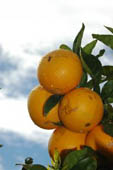
Purpose
To determine what percentage of an orange is made up of water and what percentage is made up of solids. When you're done with this experiment you'll be able to answer the question "how much water is in my orange?"
Additional information
Have you ever eaten a piece of dried fruit? If so, you probably never really put much thought into the process of how the fruit got to the dried state. Fruits like oranges, grapefruits, and lemons are mostly made up of water. The drying process removes all of that water, leaving behind just the solid elements of the fruit. In this experiment we'll take a look at exactly how much of the fruit is made up of water and how much is made up of solids.
Sponsored Links
Required materials
- An average sized orange
- Paper towel
- Aluminum foil
- Weighing scale
- Kitchen knife
- Pen or pencil
- Journal to record results and data
- Electric fan (optional)
Estimated Experiment Time
Several days
Step-By-Step Procedure
- 1. Place your orange on the weighing scale. Write the weight (grams) down in your journal. You'll need this value to determine the percentage of water in the orange later on.
- 2. Use your kitchen knife to cut your orange into thin, round slices. Don't cut the orange into wedges! We're going to need our orange to go through a drying process, and wedges will cause the orange to dry at a very slow pace. When you cut the orange, be careful not to apply too much pressure.
- 3. Cut out a sheet of aluminum foil so that it's large enough for you to spread out all of your orange slices on it.
- 4. Place your paper towel down on top of the aluminum foil in a centered position.
- 5. Weigh the aluminum foil and paper on the weighing scale. They'll only be a few grams, but you'll need this data to accurately calculate the percentage of water in your orange later on. Record the weight in your journal.
- 6. Lay your aluminum flat on a solid surface (like a table).
- 7. Spread your orange slices over the paper towel.
- 8. This step involves the drying process for the orange slices. Place the foil on a flat surface (such as a desk) in a clean, warm location where there is a steady airflow. If airflow is lacking, use an electric fan to create your own airflow. Place the fan approximately 5 feet away from the orange slices with the current directed towards them.
- 9. The drying process can take anywhere from a few hours to several days, depending on your environment. Check the progress of the drying process every 12 hours. Once fully dried, it's time to do a weigh-in.
- 10. Place the foil with the orange slices on your weighing scale. Record the weight in your journal.
- 11. Determine the percentage of water in the orange (see RESULT at the end of this experiment).
Note
The drying process can be tedious. You can speed up the process by placing the orange slices close to a heat source (such as a hot lamp) and forcing air flow, as exampled with the electric fan. Make sure your oranges are fully dried before the final weigh-in so you can get the most accurate results.
Observation
Can you think of other fruits or even vegetables that contain a lot of water? Try conducting this experiment with grapefruits, lemons, potatoes, or even a watermelon!
Result
So, what is the final percentage of the water found in your orange? Take the weight of your dried oranges and subtract the weight of the aluminum foil. For example, if your dried orange was 75 grams and your aluminum foil with the paper towel was 15 grams you would subtract 15 from 75.
Weight of dreied orange - weight of aluminum foil with paper towel = adjusted dried weight
ex: (75-15) = 60grams
To determine the percentage of solids in the orange you divide the weight of the dried orange by the weight of the orange when your first weighed it. For example, if your orange was originally 300grams and the adjusted dried weight is 60grams, you would divide 60 by 300 and multiply by 100.
(Adjusted dried weight / original weight) * 100 = solids percentage
ex: (60/300) * 100 = 20%
Finally, we determine the water percentage through the following formula.
((original weight - adjusted dried weight) / original weight) * 100 = water percentage
ex: ((300 - 60) / 300) * 100 = 80%
What was the percentage of water found in your orange?
Sponsored Links
Take a moment to visit our table of Periodic Elements page where you can get an in-depth view of all the elements,
complete with the industry first side-by-side element comparisons!